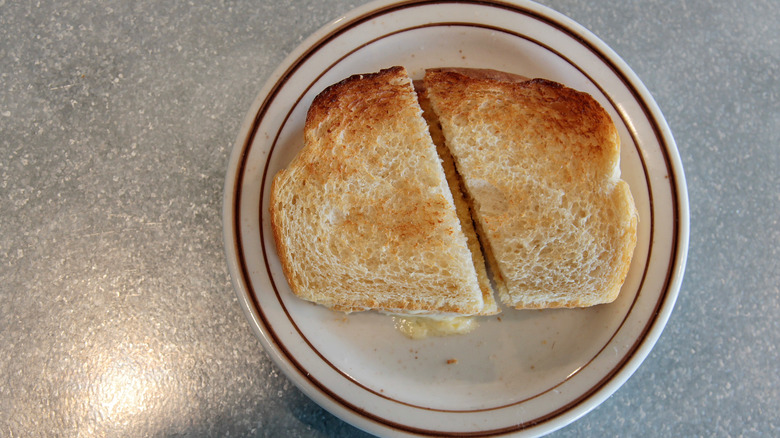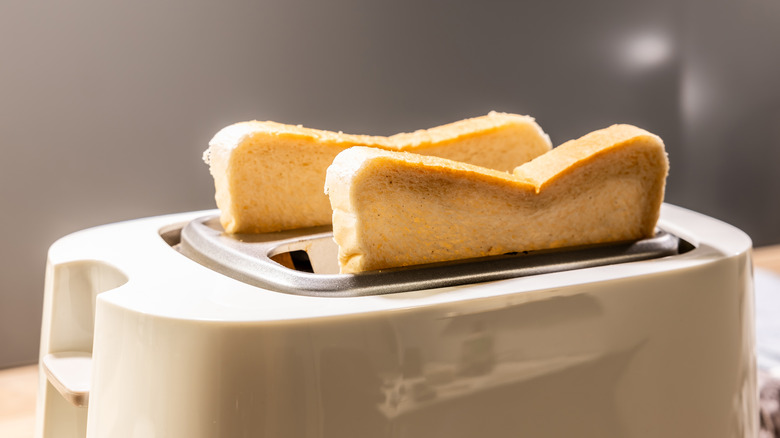What Do The Numbers On A Toaster Mean?
We may receive a commission on purchases made from links.
You might not have an intimate knowledge of every setting on your oven, and today's microwaves can have a surprising array of settings you might never touch, but the toaster? Just pop in your bread, turn the dial to the setting that you're accustomed to using, and in moments, you've got toast just the way you like it. It may seem like that's all there is to it, but in reality, there's much more to the seemingly humble toaster. A lot of people don't really think about what those numbers on the toaster's dial actually mean. For instance, maybe turning the dial to setting 2 results in your perfect slice. That time you weren't paying attention and set it to 4 by accident, perhaps, resulted in a burnt mess that ruined your entire morning. But what of the numbers themselves? It's sometimes assumed that the setting chosen indicates how many minutes the toast will cook for, but this generally isn't the case.
There are toaster models that allow the user to set a cooking time in minutes, in a similar fashion to a microwave. In such cases, that's what the numbers are referring to. Hommater, for instance, offers a two-slice toaster with an LCD screen and countdown timer. However, the model also features the option of using a "browning control," and it's this setting that's most commonly used by toasters. It does determine how long a given slice is in the toaster for, but it's more about how thoroughly that piece is browned. You could even consider the numbers from low to high to be a sort of rudimentary version of the steak scale, from rare to well done.
A browning control's role in the perfect slice
Everybody likes to think that the amount of milk they put in their tea is as correct as the amount of time they personally toast their bread for. The important thing is that toaster manufacturers give users the options to eat it as they like it, which is where that handy browning control comes in. Breville's user manual for the BTA820XL smart toaster notes that "1" is the "lightest" setting and "5" the "darkest." It's a simple and self-explanatory system intended to cover a wide spectrum of things you might be hungrily toasting. Breville elaborates, "raisin toast and white light-textured breads may require a lighter setting, while heavier textured rye breads may require a darker setting."
Finding the best combination of bread variety and browning setting for you is what the thrilling world of toaster cuisine is all about. There's a type of toast and a type of toaster for everybody, including the Xbox toaster. Again, though, there's more to it than you might think. We might be used to just flipping the switch and waiting, but there's a lot going on inside that toaster. Another thing to bear in mind is the relationship between the setting chosen and the heat the bread is exposed to.
How toasters work
A slice of bread fresh from the slot of a toaster, cooked on the highest setting, can look distinctly charred. The lowest setting, meanwhile, might barely scorch the slice, particularly if it's a thicker, hardier bread. The temperature in the toaster in both instances can be just the same. What the numbers on the toaster mean is how long the heat lasts. Daniil Nikitichev, of University College London's Department of Medical Physics, explains the simple brilliance of toaster technology: "The dial controls how much electricity goes through the switch. A lower number on the dial equates to a higher current with more heat running through the circuit, this triggers the off switch sooner, so the bread is toasted less." This is the process with toasters that employ capacitors.
Like electromagnetic railguns, toasters also work through electromagnets. Those that feature a bimetallic strip are now less common. These more classic toasters make use of their heat in a rather different way. The temperature doesn't cause the metals in the strip to expand at the same rate, with the end result being a curve in the component. This movement breaks the electromagnetic connection at a point determined by the toaster's settings, and when it does, out pops your toast. If you're unsure which type of toaster you have, your ever-trusty user manual will have the answers as to exactly what those numbers represent. Whatever you do, though, you may not get the same results every time. An older toaster that uses a bi-metallic strip is particularly prone to inconsistency: The toasting time will differ a lot for a subsequent batch because some of that heat from the last one will have been retained. Therefore, the action will be faster.


